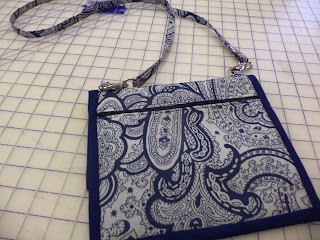Sewing Knits at Sewing Retreat
Have you ever been to a sewing retreat where you can spend
the day and as much of the night as you wish just sewing and visiting with
others who enjoy sewing? It is really
fun and productive! I just returned from
a sewing retreat with the Lansing Clippers Chapter of the American Sewing
Guild. I had an enjoyable time and came
back with four new tops ready for fall.
I also returned home inspired by the projects I saw others making. I will soon be sewing with new ideas I got
from other sewers and with a new burst of energy.
This year I took four knit tops to sew for my fall and
winter wardrobe. I cut them out at home
in an effort to save some time at the retreat.
I wanted to be ready to sew as soon as I unpacked. I even serged the edges before I left. I did not serge the necklines and
armscyes. I thought that might distort
them or have an impact on the fit of the sleeves and neck.
I cut two of the tops from McCall’s M6964 and two from Kwik
Sew 2900. I used 5 different types of
knit fabric. There was mid-weight cotton
knit, a loosely-woven sweater knit, a firmly-woven sweater knit, a very
stretchy slinky-type knit, and a printed knit that had only a little
stretch. I had used both the McCall and
Kwik Sew pattern many times but with a different type of knit fabric. I realized that each of the four tops would
probably fit me differently. To be
prepared for that situation, I cut each one ¼ inch larger at the side seams
than my original two patterns. I can
always take a large seam allowance, if needed.
I combined the stretchy slinky-type knit with the printed
knit to make a top with a yoke. I made
the yoke and sleeves from the printed knit and used the lilac slinky-type
fabric for the lower front and back. I
used McCal’s M6964 for this top, so it has bust darts. I did not make any alterations to the
garment. I sewed it exactly as I cut it
and used a 5/8” seam. It fits okay, but
I probably could have left off the additional ¼” on the front and back at the
side seams because the slinky-type knit has a lot of stretch. A picture of the top is shown below.
Next, I sewed the loosely woven sweater knit using Kwik Sew 2900 with no bust darts. I definitely did not need the extra ¼” I added to the front and back at the side seams. I sewed the shoulder seams together and then used a ½ inch seam to baste the front and back together although the pattern called for ¼” seams. I checked the fit and the top was still too large so I took another ¼” in at the side seams. That worked much better; however, when I put on the top, it stood out away from my body at the hem edge. I decided to add a band at the bottom to see if that would cause the top to lie flat. The finished band width was 1 ¼” and it resolved the problem. I used stay tape in the shoulder seams of this top as well as the others. It keeps the shoulder seams in place and prevents stretching.
The neckline of this top is larger than the other top made with the same pattern. That is caused by the loose weave of the fabric. I should have stabilized the neckline as soon as I cut it, but I did not do that. Now that I have the band sewed onto the neckline, I will seek another solution to the problem. I am thinking I might sew a turtleneck dickey for this top. A picture of this top is shown below.
The third top I made was also a sweater knit, but it was much more closely woven than the black top. I had no problems with it except I did not need that extra ¼” I added to the side seams, so I just took larger seams at the sides. The fabric was much easier to work with than the knit shown above. A picture of the finished green top is shown below.
The fourth top I made was an aqua mid-weight cotton knit. I used McCall’s 6964 pattern. I did not need the extra ¼” I added to the side seams. It went together quickly without problems. It does look a little plain, so I am thinking I may add an embroidery design to it at a later date. A picture of the garment is shown below.
A good resource for sewing knits is the book, Knits
for Real People by Susan Neall and Pati Palmer. There is also an article about how to
stabilize knits with stay tape in the current edition of Threads Magazine. It is the Fall 2021 Number 215 edition and
the article is on page 66. Too bad I did
not read the article before going to the retreat. If I had, I might have handled the neckline
of my black top differently!
I hope you will make something from knit fabric soon. If you haven’t sewn with knits, do some
research before you begin. Have fun
sewing whatever projects you choose!
Judy










